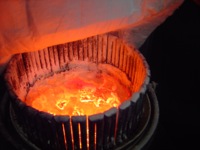Difference between revisions of "Crucible"
m (Text replacement - "http://nordan.daynal.org" to "https://nordan.daynal.org") |
m (Text replacement - "http://" to "https://") |
||
| Line 3: | Line 3: | ||
==Origin== | ==Origin== | ||
[https://nordan.daynal.org/wiki/index.php?title=English#ca._1100-1500_.09THE_MIDDLE_ENGLISH_PERIOD Middle English] ''corusible'', from Medieval Latin ''crucibulum'' earthen pot for melting metals | [https://nordan.daynal.org/wiki/index.php?title=English#ca._1100-1500_.09THE_MIDDLE_ENGLISH_PERIOD Middle English] ''corusible'', from Medieval Latin ''crucibulum'' earthen pot for melting metals | ||
| − | *[ | + | *[https://en.wikipedia.org/wiki/15th_century 15th Century] |
==Definitions== | ==Definitions== | ||
*1: a vessel of a very refractory material (as porcelain) used for melting and calcining a substance that requires a high degree of [[heat]] | *1: a vessel of a very refractory material (as porcelain) used for melting and calcining a substance that requires a high degree of [[heat]] | ||
| Line 13: | Line 13: | ||
The form of the crucibles has varied through [[time]], with designs [[reflecting]] the [[process]] for which they are used, as well as regional variation.The crucible helps to prevent the [[heat]] from affecting the solution. The earliest crucible forms derive from the sixth/fifth millennium B.C. in Eastern Europe and Iran. | The form of the crucibles has varied through [[time]], with designs [[reflecting]] the [[process]] for which they are used, as well as regional variation.The crucible helps to prevent the [[heat]] from affecting the solution. The earliest crucible forms derive from the sixth/fifth millennium B.C. in Eastern Europe and Iran. | ||
| − | Crucibles and their covers are made of high temperature-resistant materials, usually [ | + | Crucibles and their covers are made of high temperature-resistant materials, usually [https://en.wikipedia.org/wiki/Porcelain porcelain] or an inert metal. One of the earliest uses of [https://en.wikipedia.org/wiki/Platinum platinum] was to make crucibles. Ceramics such as [https://en.wikipedia.org/wiki/Alumina alumina], [https://en.wikipedia.org/wiki/Zirconia zirconia], and especially [https://en.wikipedia.org/wiki/Magnesium_oxide magnesia] will tolerate the highest temperatures. More recently, metals such as [https://en.wikipedia.org/wiki/Nickel nickel] and zirconium have been used. The lids are typically loose-fitting to allow gases to escape during heating of a sample inside. Crucibles and their lids can come in high form and low form shapes and in various sizes, but rather small 10–15 ml size porcelain crucibles are commonly used for [https://en.wikipedia.org/wiki/Gravimetric_chemical_analysis gravimetric chemical analysis]. These small size crucibles and their covers made of porcelain are quite cheap when sold in quantity to [[laboratories]], and the crucibles are sometimes disposed of after use in precise quantitative chemical analysis. There is usually a large mark-up when they are sold individually in hobby shops.[https://en.wikipedia.org/wiki/Crucible] |
[[Category: Chemistry]] | [[Category: Chemistry]] | ||
Latest revision as of 23:40, 12 December 2020
Origin
Middle English corusible, from Medieval Latin crucibulum earthen pot for melting metals
Definitions
- 1: a vessel of a very refractory material (as porcelain) used for melting and calcining a substance that requires a high degree of heat
- 2: a severe test
- 3: a place or situation in which concentrated forces interact to cause or influence change or development <conditioned by having grown up within the crucible of Chinatown — Tom Wolfe>
Description
A crucible is a container that can withstand very high temperatures and is used for metal, glass, and pigment production as well as a number of modern laboratory processes. While crucibles historically were usually made from clay, they can be made from any material that withstands temperatures high enough to melt or otherwise alter its contents.
The form of the crucibles has varied through time, with designs reflecting the process for which they are used, as well as regional variation.The crucible helps to prevent the heat from affecting the solution. The earliest crucible forms derive from the sixth/fifth millennium B.C. in Eastern Europe and Iran.
Crucibles and their covers are made of high temperature-resistant materials, usually porcelain or an inert metal. One of the earliest uses of platinum was to make crucibles. Ceramics such as alumina, zirconia, and especially magnesia will tolerate the highest temperatures. More recently, metals such as nickel and zirconium have been used. The lids are typically loose-fitting to allow gases to escape during heating of a sample inside. Crucibles and their lids can come in high form and low form shapes and in various sizes, but rather small 10–15 ml size porcelain crucibles are commonly used for gravimetric chemical analysis. These small size crucibles and their covers made of porcelain are quite cheap when sold in quantity to laboratories, and the crucibles are sometimes disposed of after use in precise quantitative chemical analysis. There is usually a large mark-up when they are sold individually in hobby shops.[1]
